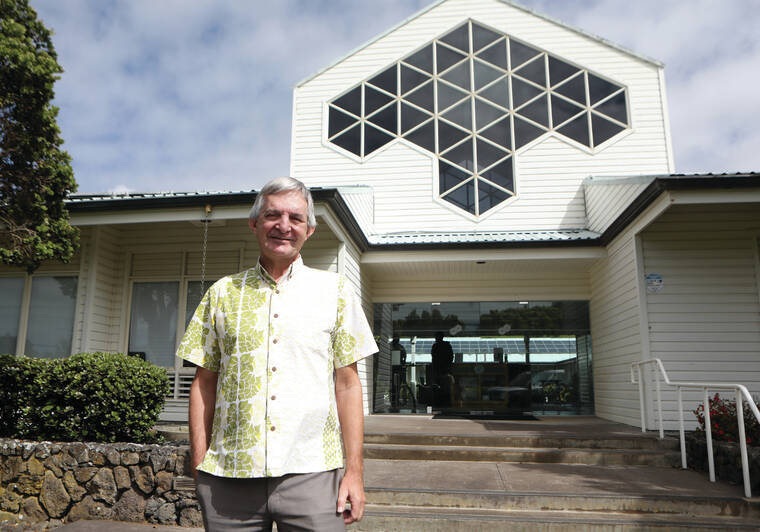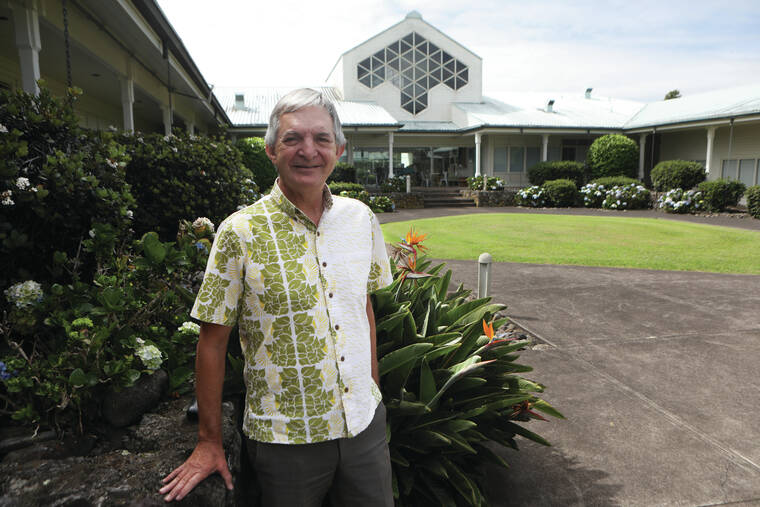When Hilton Lewis began working at the W. M. Keck Observatory in 1986, astronomy was a very different field.
The Hubble Space Telescope was still four years away from launching, and Keck’s Maunakea telescopes wouldn’t be completed for five. The International Space Station was little more than a concept. Black holes and exoplanets had never been directly observed, and even Pluto was still considered a planet.
Lewis, who is retiring from Keck at the end of the month after 37 years, the last nine of which he served as observatory director, said he was lucky to join the observatory at the start of what has become “a golden age for astronomy.”
“Thirty-seven years ago, telescopes had been stuck at the 200-inch scale for years,” Lewis said. “Keck was one of the first observatories to use active optics … and that’s allowed us to examine certain physics and events that were impossible before.”
The two Keck telescopes on Maunakea were the first to use segmented primary mirrors, allowing them to become the largest ground-based telescopes of their time — “with tiled mirrors, you can make them as big as you like,” Lewis explained — and opening doors to vast new fields of study. Lewis said a Keck telescope collects 6 million times more light than the human eye can.
At the same time, the development of laser adaptive optics, which allows observatories to finely correct for the atmosphere’s distortion of light, has improved the image quality of modern telescopes to an astronomical degree.
Doug Simons, director of the University of Hawaii’s Institute for Astronomy, said Keck’s technological advancements can be taken for granted now, but were at the time unproven and risky. Yet, that habit for pushing boundaries, he said, has led to the entire field of astronomy using techniques pioneered at Keck.
“Keck made the very first transit measurement of an exoplanet,” Simons said, adding that such measurements — detecting exoplanets by observing their host stars dimming as the planets pass between them and the Earth — are practically commonplace now.
“The study of exoplanets, for example, was really a dead-end field,” Lewis said. “And now it’s this huge field, and we’re able to discover smaller and smaller exoplanets every day. … The Holy Grail is an Earth-sized exoplanet in its star’s habitable zone, because that’s where we’d most likely see life develop, and we’re not there yet. But we’re getting close.”
Lewis also was presiding over Keck when astrophysicist Andrea Ghez used the telescope to observe the center of the Milky Way and confirmed the presence of a black hole at the galaxy’s heart, for which she was awarded the Nobel Prize in Physics in 2020.
Lewis, who began work at Keck as a software engineer, has been fascinated by physics and space since childhood.
He said that while growing up in South Africa, he entered into a science competition at around the age of 15. And while he said that he couldn’t recall the details of that competition, it was then that he encountered a NASA scientist who ultimately convinced him to pursue science as a career.
“It shows that reaching out to kids is so, so important,” Lewis said. “You never know who you’re going to turn on to science.”
Meanwhile, Lewis said the next 37 years of astronomy look even brighter.
New instruments and facilities like the recently launched James Webb Space Telescope and the under-construction Vera C. Rubin Observatory in Chile will widen mankind’s view of the universe. Lewis said the latter facility will be able to observe the entirety of the sky in a week, allowing astronomers to detect briefer, more transient celestial events.
“We can expect to see a million events a night,” Lewis said. “Of course, then we’ll need to sift through them all to find the interesting ones.”
Lewis added that the eventual construction of a “very large telescope” — whether it be the European Extremely Large Telescope under construction in Chile or the Thirty Meter Telescope on Maunakea — will push the field still further, although he said that his time at Keck also has exposed to him how astronomy still must improve in other ways.
“2019 was a challenging period, no question,” Lewis said, referring to the TMT protests on Maunakea. “We learned how we’re perceived by many of the Hawaiian people, and that was difficult.”
However, Lewis went on, he believes that the newly formed Maunakea Stewardship and Oversight Authority represents a path forward for both Native Hawaiians and astronomy on the mountain, so long as people “are willing to give it a shot.”
But whether on Maunakea or elsewhere, Lewis said astronomy inevitably will continue to thrive and advance.
“Human beings are insatiably curious,” Lewis said. “From the earliest days, it’s always been about that sense of wonder we get from looking at the night sky … and astronomy is really the crucible of physics. A lot of physics experiments can only be tested through astrophysics.”
When Lewis steps down on May 30, he will be replaced by an interim director Rich Matsuda, currently the observatory’s associate director of external relations, and whom Simons referred to as “sort of universally known as being a great guy.”
“He’s exactly the sort of person we need,” Lewis said. “I go back 30 years with him, and he’s always been great at outreach, talking to people.”
Email Michael Brestovansky at mbrestovansky@hawaiitribune-herald.com.









